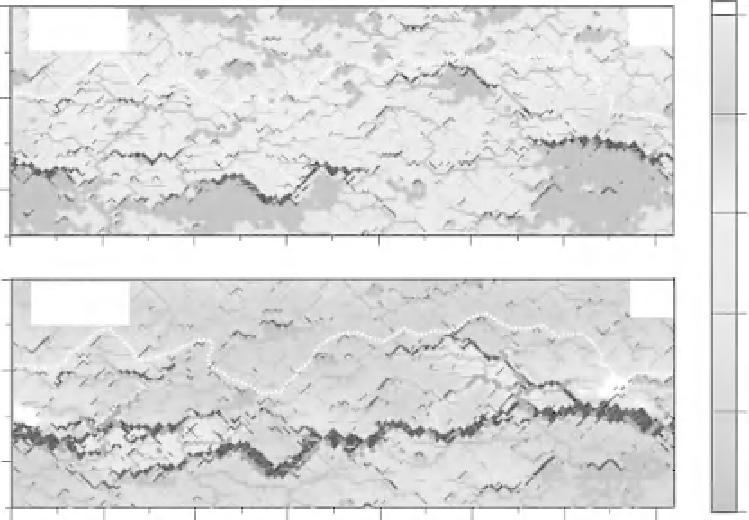Environmental Engineering Reference
In-Depth Information
100
2000
(a)
4.8 My
80
1600
60
1200
100
(b)
5.6 My
800
80
400
60
0
0
20
40
60
80
100
120
140
x [km]
Catchment/Depocentre summary
20 km
d
Hinterland
catchments
(ii)
(v)
Drainage
reversal
(vi)
(iv)
(iii)
(i)
Q
Frontal
catchments
M
P
Defeated
channel
N
Frontal
catchments
Drainage
deflection
Catchments
(i)
Depocentres M
Fault scarps
(c)
Figure 19.5
Topography and drainage patterns predicted by the
Cascade
landscape-evolution model coupled to a dynamic model of
extensional fault interaction. (a) After 4.8 My of model evolution, just before linking of individual fault segments into a major
rift-bounding fault. (b) At 5.6 My, after fault linkage has occurred. Colour scale for topography is shown on the right; blue lines and
dots are modelled rivers and lakes, respectively; black lines are faults, the thickness of which corresponds to the total throw; white
dashed line shows main drainage divide; red dots are locations of bedrock landslides. (c) Geomorphologic interpretation of model
evolution, summarising overall catchment/depocentre geometry, drainage evolution, position of the linked fault scarp and main
drainage divide. Large black arrows indicate main sediment sources for the hangingwall basin (Adapted with permission from Cowie,
P. A., Attal, M., Tucker, G. E.
et al
. (2006) Investigating the surface process response to fault interaction and linkage using a
numerical modelling approach,
Basin Res.
, 18, 231-66, doi:10.1111/j.1365-2117.2006.00298.x).
interest in these morphologic features. First, 'great
escarpments' at rifted continental margins constitute
the largest scale morphologic features on the continents
outside active orogens, and their geodynamic significance
has remained controversial for decades. Second, several
large
been collected in the 1980s and early 1990s across
rifted-margin escarpments and showed that they were
long-lived features recording a major pulse of denudation
in the early post-rift phase, with denudation rates slowing
down significantly later on (e.g. Gallagher
et al
., 1998
and references therein). Finally, the relatively simple
fission-track
thermochronology
databases
had





















Search WWH ::

Custom Search